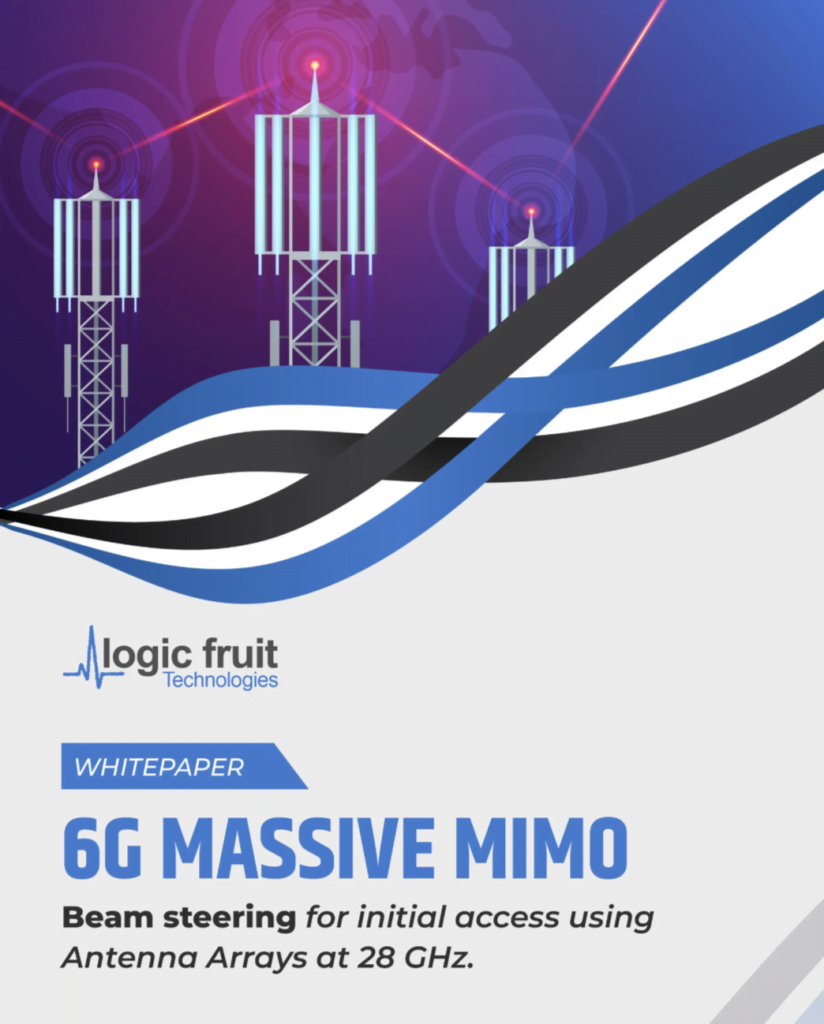Wireless communication has undergone a remarkable transformation over the past few decades, evolving from basic radio transmissions to sophisticated systems capable of delivering high-speed data and multimedia content seamlessly.

Latest Whitepaper on 6G MIMO Beam
This evolution has been driven by a relentless pursuit of improved performance, efficiency, and reliability in wireless networks, spurred by the ever-growing demand for connectivity across diverse applications and devices.
Central to this evolution are two key technologies: Beamforming and Multiple Input Multiple Output (MIMO).
Beamforming, also known as spatial filtering, is a signal-processing technique used to optimize the transmission and reception of radio signals in wireless communication systems.
By focusing energy in specific directions, beamforming enhances signal strength, mitigates interference, and improves overall spectral efficiency.
In parallel, MIMO technology has emerged as a fundamental enabler of high-performance wireless communication.
MIMO exploits the spatial dimension by employing multiple antennas at both the transmitter and receiver ends, thereby increasing data throughput, enhancing reliability, and extending coverage.
By leveraging spatial diversity and multiplexing gains, MIMO systems can achieve significant improvements in spectral efficiency and overall network capacity.
The integration of beamforming and MIMO technologies has revolutionized the design and operation of wireless communication systems, paving the way for the deployment of advanced networks such as 4G LTE, Wi-Fi, and the upcoming 5G and beyond.
These technologies are not only instrumental in meeting the growing demands for high-speed data services but also in enabling emerging applications such as the Internet of Things (IoT), autonomous vehicles, and virtual reality.
In this paper, we delve into the profound impact of beamforming and MIMO Beam technologies on wireless communication systems.
We explore the underlying principles, key advancements, and practical implementations of these technologies across various wireless standards and applications. Additionally, we examine the implications of beamforming and MIMO for future wireless networks, addressing challenges and opportunities on the horizon.
Beamforming Technology
Beamforming technology represents a significant advancement in wireless communication systems, offering targeted signal transmission and reception capabilities that enhance performance and efficiency. This section provides an in-depth exploration of beamforming principles, techniques, and applications.
A. Principles of Beamforming:
- Spatial Signal Processing: Beamforming leverages spatial signal processing techniques to manipulate the directionality of transmitted or received signals.
- Array Antennas: Beamforming relies on antenna arrays, where multiple antenna elements are strategically positioned to form desired radiation patterns.
- Phase Control: By adjusting the phase of signals across antenna elements, beamforming steers the transmitted or received beams toward specific directions.
B. Types of Beamforming:
- Analog Beamforming: Analog beamforming involves adjusting the phase of signals at the antenna level, typically using phase shifters, to steer beams without digital signal processing.
- Digital Beamforming: Digital beamforming employs digital signal processing algorithms to manipulate signal phases at the baseband level, offering more flexibility and precise beam control.
- Hybrid Beamforming: Hybrid beamforming combines elements of analog and digital beamforming, offering a balance between performance and complexity.
C. Beamforming Techniques:
- Uniform Linear Array (ULA): ULA configurations employ linear antenna arrays with uniform spacing, suitable for applications requiring beam steering in a single dimension.
- Uniform Planar Array (UPA): UPA configurations consist of planar antenna arrays with uniform element spacing, enabling beamforming in two dimensions for wider coverage.
- Adaptive Beamforming: Adaptive beamforming techniques dynamically adjust beamforming parameters based on environmental conditions and signal characteristics, optimizing performance in changing scenarios.
D. Applications of Beamforming:
- Wireless Communication: Beamforming enhances the coverage, capacity, and reliability of wireless communication systems such as cellular networks, Wi-Fi, and satellite communications.
- Radar Systems: Beamforming is widely used in radar systems for target detection, tracking, and imaging, enabling precise spatial localization and discrimination.
- Acoustic Beamforming: In acoustic applications, such as microphone arrays and sound systems, beamforming is utilized for noise reduction, spatial audio capture, and beam steering.
E. Advantages and Challenges:
- Advantages: Beamforming improves signal quality, extends coverage range, mitigates interference, and enhances spectral efficiency, leading to better overall performance.
- Challenges: Beamforming systems require accurate channel estimation, synchronization, and coordination, while also facing limitations in terms of hardware complexity and power consumption.
MIMO Technology
A. Introduction to MIMO:
Multiple Input Multiple Output (MIMO) is a key technology in wireless communication systems that utilizes multiple antennas at both the transmitter and receiver ends.
Unlike traditional single-input single-output (SISO) systems, MIMO systems leverage spatial diversity and multiplexing to enhance performance.
MIMO enables simultaneous transmission of multiple data streams over the same frequency channel, thereby increasing data throughput and improving reliability.
B. Principles of MIMO:
- Spatial Diversity: MIMO exploits the spatial dimension by transmitting multiple independent data streams through different antenna paths.
- Spatial Multiplexing: MIMO systems can transmit multiple data streams simultaneously over the same frequency channel, effectively increasing the data rate.
- Spatial Processing: MIMO employs advanced signal processing techniques to optimize signal transmission and reception, mitigating channel impairments and enhancing performance.
C. Advantages of MIMO:
- Increased Data Throughput: By transmitting multiple data streams simultaneously, MIMO systems can achieve higher data rates compared to SISO systems.
- Improved Reliability: MIMO leverages spatial diversity to combat fading and mitigate the effects of multipath propagation, resulting in more robust wireless connections.
- Enhanced Coverage and Range: MIMO technology enables better coverage and extends the range of wireless networks, particularly in challenging environments with obstacles and interference.
D. Implementation of MIMO:
- Antenna Configuration: MIMO systems require multiple antennas at both the transmitter and receiver ends, with configurations ranging from 2×2 to 8×8 or more.
- Signal Processing Algorithms: MIMO systems employ sophisticated signal processing algorithms, such as maximum likelihood (ML), zero-forcing (ZF), and minimum mean square error (MMSE), to extract the transmitted signals from the received data.
- Channel Estimation and Feedback: MIMO systems rely on accurate channel estimation and feedback mechanisms to adaptively adjust transmission parameters and optimize performance in dynamic wireless environments.
E. Applications of MIMO:
- Wireless LANs (Wi-Fi): MIMO technology is widely deployed in Wi-Fi networks to achieve higher data rates, improve coverage, and support multiple users simultaneously.
- 4G LTE and Beyond: MIMO is an integral part of 4G LTE and upcoming 5G networks, enabling gigabit-speed connections, low latency, and massive connectivity for diverse applications.
- Point-to-Point and Point-to-Multipoint Links: MIMO technology is also used in point-to-point and point-to-multipoint wireless links, such as backhaul connections and fixed wireless access (FWA) deployments.
F. Challenges and Future Directions:
- Spectrum Efficiency: As wireless networks become increasingly congested, optimizing spectrum efficiency remains a key challenge for MIMO technology.
- Massive MIMO: The evolution towards massive MIMO systems with hundreds or even thousands of antennas poses new challenges in terms of hardware complexity, signal processing, and energy efficiency.
- Integration with Other Technologies: Future wireless networks are expected to integrate MIMO with other advanced technologies such as beamforming, full-duplex communication, and cognitive radio to further enhance performance and capacity.
Integration of Beamforming and MIMO
A. Synergy between Beamforming and MIMO:
Beamforming and MIMO technologies are often integrated synergistically to achieve enhanced performance in wireless communication systems.
While beamforming focuses on spatially shaping the radio signals to improve link quality and coverage, MIMO exploits spatial diversity and multiplexing gains to increase data throughput and reliability.
By combining these techniques, wireless systems can leverage the benefits of both beamforming and MIMO, leading to improved spectral efficiency, extended coverage, and enhanced overall performance.
B. Hybrid Beamforming in MIMO Systems:
In MIMO systems, hybrid beamforming techniques are commonly employed to strike a balance between the complexity of fully digital beamforming and the efficiency of analog beamforming.
Hybrid beamforming utilizes a combination of digital and analog beamforming components to achieve beamforming effects with reduced hardware complexity and power consumption.
This approach enables MIMO systems to exploit the spatial domain efficiently while addressing practical constraints such as hardware limitations and power consumption, making it well-suited for real-world deployment.
C. Adaptive Beamforming and MIMO Transmission:
Adaptive beamforming techniques, such as adaptive array processing and adaptive MIMO transmission, further enhance the synergy between beamforming and MIMO.
Adaptive beamforming algorithms dynamically adjust the antenna weights and beamforming parameters based on channel conditions, optimizing the transmission and reception performance.
By adapting to changing channel characteristics, adaptive beamforming and MIMO transmission techniques maximize spectral efficiency, mitigate interference, and improve link reliability in dynamic wireless environments.
D. Applications of Integrated Beamforming and MIMO:
The integration of beamforming and MIMO find applications across various wireless standards and use cases.
In cellular networks, integrated beamforming and MIMO techniques are deployed to enhance capacity, coverage, and user experience, particularly in dense urban environments and indoor scenarios.
In wireless LANs and point-to-point communication systems, integrated beamforming and MIMO enable high-throughput data transmission, robust connectivity, and seamless mobility for multimedia streaming, gaming, and other bandwidth-intensive applications.
E. Future Directions and Challenges:
As wireless communication continues to evolve, the integration of beamforming and MIMO is expected to play a pivotal role in shaping the next generation of wireless networks.
Future research directions include the development of advanced beamforming and MIMO algorithms, the exploration of millimeter-wave and massive MIMO technologies, and the integration of beamforming and MIMO with emerging network architectures such as cloud RAN and network slicing.
However, challenges such as hardware complexity, synchronization issues, and regulatory considerations remain to be addressed to fully realize the potential of integrated beamforming and MIMO in future wireless systems.
Challenges and Future Directions
A. Challenges in Beamforming and MIMO Implementation:
- Complexity and Cost: Implementing beamforming and MIMO techniques often requires sophisticated signal processing algorithms and multiple antennas, which can increase system complexity and cost.
- Channel Variability: Wireless channels are inherently dynamic and subject to variations in propagation conditions, leading to challenges in maintaining optimal beamforming and MIMO performance.
- Interference Mitigation: Beamforming and MIMO systems are susceptible to interference from other users or sources, necessitating robust interference mitigation techniques to maintain signal integrity.
- Hardware Limitations: Practical implementations of beamforming and MIMO may face constraints related to hardware capabilities, such as antenna spacing, size, and power consumption.
B. Future Directions in Beamforming and MIMO:
- Hybrid Beamforming: Hybrid beamforming architectures, combining analog and digital beamforming techniques, offer a compromise between performance and complexity, enabling efficient utilization of antenna arrays in future wireless systems.
- Massive MIMO: The deployment of massive MIMO systems, with a large number of antennas at base stations, promises significant gains in spectral efficiency and coverage, paving the way for the realization of ultra-dense networks and beyond.
- Millimeter Wave (mmWave) Communication: Exploiting the abundant spectrum resources in the millimeter-wave frequency bands, beamforming, and MIMO technologies hold immense potential for enabling high-capacity, short-range communications in future 5G and beyond networks.
- Machine Learning Techniques: Leveraging machine learning algorithms for beamforming and MIMO optimization can enhance adaptability and performance in dynamic wireless environments, enabling autonomous and intelligent wireless systems.
C. Addressing Spectrum Scarcity:
With the exponential growth in wireless data traffic, spectrum scarcity has become a pressing concern. Future research directions include spectrum-sharing techniques, cognitive radio systems, and dynamic spectrum access to maximize spectral efficiency and alleviate spectrum congestion.
D. Security and Privacy Considerations:
As wireless communication becomes increasingly pervasive, ensuring the security and privacy of transmitted data becomes paramount. Future developments in beamforming and MIMO should incorporate robust security mechanisms to safeguard against eavesdropping, jamming, and other malicious attacks.
E. Standardization and Interoperability:
Standardization bodies play a crucial role in shaping the adoption and interoperability of beamforming and MIMO technologies across different wireless standards and ecosystems. Continued efforts in standardization and harmonization will be essential to facilitate seamless integration and global deployment of these technologies.
Conclusion
Beamforming and Multiple Input Multiple Output (MIMO) technologies have emerged as cornerstones in the advancement of wireless communication systems, revolutionizing the way data is transmitted, received, and processed. Throughout this paper, we have explored the profound impact of beamforming and MIMO on wireless networks, spanning from their fundamental principles to their practical implementations and future directions.
These technologies have enabled significant improvements in spectral efficiency, coverage, and reliability, addressing the ever-growing demand for high-speed data services and supporting a myriad of applications across diverse domains. By leveraging spatial diversity, beamforming and MIMO have unlocked new opportunities for innovation, driving the evolution of wireless networks from 4G LTE to the upcoming 5G and beyond.
However, the journey of beamforming and MIMO is not without its challenges. From mitigating interference to addressing hardware limitations and spectrum scarcity, numerous obstacles must be overcome to fully harness the potential of these technologies. Yet, with each challenge comes an opportunity for innovation and advancement.
Looking ahead, the future of beamforming and MIMO holds immense promise. Hybrid beamforming architectures, massive MIMO systems, and millimeter-wave communication are just a few examples of the exciting developments on the horizon. Moreover, the integration of machine learning techniques and advancements in security and privacy will further enhance the capabilities and resilience of beamforming and MIMO-enabled wireless networks.
In conclusion, beamforming and MIMO technologies continue to shape the landscape of wireless communication, driving progress and innovation in the quest for faster, more reliable, and ubiquitous connectivity. By addressing challenges, embracing emerging trends, and fostering collaboration across industry and academia, we can unlock the full potential of beamforming and MIMO to propel wireless communication into a new era of connectivity and empowerment.












